Chess Lessons Next: Tactics The Essence of Chess
The Royal Game of Chess
"Every chess master was once a beginner." - Chernev
Basics- Rules and Piece Movement For Each Chess Piece
Objective
Checkmate: If your opponent’s King is being attacked ergo would be captured on the next move, that’s called “check.” If your opponent has no way to save the King from that situation, that’s “checkmate,” and you’ve won.
Tie Games
When the King is not in check but there is no legal move left, the game is tied in a stalemate. The game can also be considered a draw if the pieces enter a repetitive cycle of three identicle board positions. For instance, if you move a piece, your opponent threatens, you move back to the previous position with the same piece, and then this whole pattern repeats twice more, the game may be considered a draw. The game may also be drawn By the 50 Move rule: Hence if no pawn moves or captures are made within 50 moves the game may be claimed as a draw due to lack of progress.
Movement & Play
You and an opponent alternate moves. As a standard White always goes first.
All pieces other than Pawns can move either forward or backward.
The King: The King can move one adjacent square in any direction – diagonal, vertical, or horizontal – unless the move would put it in check. It will capture an enemy piece occupying the square it moves into.
| The King |
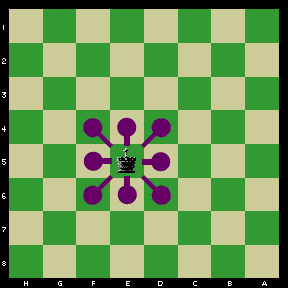 |
|
 The king may move one square in any direction, including diagonally. In the diagram, the king may move to any square with a purple dot. The king may move one square in any direction, including diagonally. In the diagram, the king may move to any square with a purple dot. |
Queen: The Queen is the most powerful piece. She can move any distance in a straight line,
diagonal, vertical, or horizontal, as long as her path is clear.
The Queen cannot jump over any pieces. She captures a piece by occupying its square.
| The Queen |
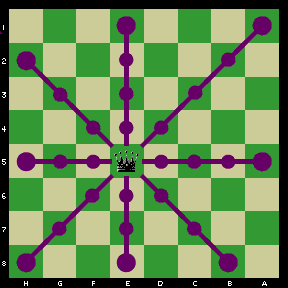 |
|
 The queen moves any number of squares horizontally, vertically, or diagonally, but it may not jump over other pieces. The queen moves any number of squares horizontally, vertically, or diagonally, but it may not jump over other pieces.
|
Rook: The Rook is second in power to the Queen in most positions.
The Rook can move in a straight line along empty squares either vertically or horizontally but not diagonally.
Thus giving it control of both colors with long distance control over every square horizontaly or vertically in front and behind it.
This allows the rook to be used as a means of hearding a lone King towards his doom (checkmate with Rook & King Versus King)
with no means of escape but stalemate. Hence the reason The Rook is considered second only to the Queen.
A lone Rook working with its king against a lone king can force checkmate!
Further More as the rook cuts off horizontal (ranks) and verticle files
Two Rooks can work in unison essentially rolling the enemy king back one rank at a time.
One rook cuts off the escape while the other gives check forcing the king to keep moving back
until his back is against the cliff edge of the board
where soon he will perish!
| The Rook |
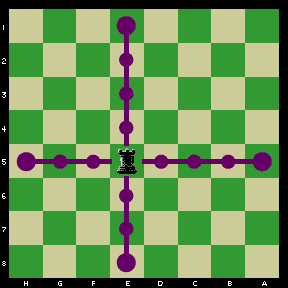 |
|
 The rook moves any number of squares horizontally or vertically, but it may not jump over other pieces. In the diagram, the rook may move to any square along the lines shown, provided its path is clear. The rook moves any number of squares horizontally or vertically, but it may not jump over other pieces. In the diagram, the rook may move to any square along the lines shown, provided its path is clear.
|
Bishop: The Bishop moves diagonally any number of empty squares. Each Bishop is restricted to moving on squares of the color it started out on.
As opposed to a Rook and a King against a lone King, The Bishop Cannot force Checkmate without the help of other pieces
as the Enemy king can always escape by moving to the squares opposite the color that the bishop controlls. A perfect reason why two Bishops work well together Known as the Bishop Pair they can Control both colors and while harder than a Rook vs King ending a Bishop Pair can force checkmate together.
| The Bishop |
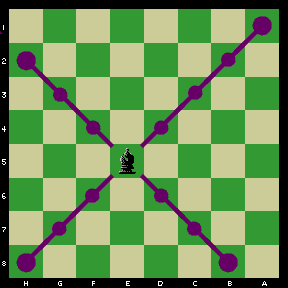 |
|
 The bishop moves any number of squares along diagonals, but it may not jump over other pieces. In the diagram, the bishop may move to any square along the lines shown, provided its path is clear. The bishop moves any number of squares along diagonals, but it may not jump over other pieces. In the diagram, the bishop may move to any square along the lines shown, provided its path is clear. |
Knight: The Knight moves in L formation by going two steps vertical and one step horizontal, or one step vertical, two steps horizontal. Knights can jump over other pieces. For example, in the beginning of the game, you can move the Knight first, by jumping over the Pawn. The Knight cannot capture the pieces it jumps over, only the piece on the square where it lands.
The knight is considered a slower moving piece since it cannot zoom across the board like the long range pieces. It's unique movement however still can creat surprise tactics almost out of nowhere "the knight is the springer of surprises"
| The Knight |
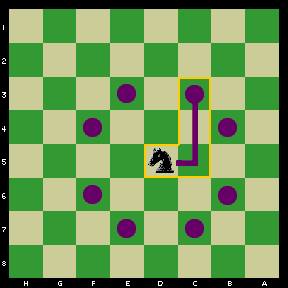 |
|
 The knight moves from one corner to the other of a 2x3 rectangle of squares. Unlike other pieces, a knight may jump over other pieces (belonging to either player) to make its move, It does not capture the pices it hops over but does capture any piece on its landing square. In the diagram, the knight may move to any square with a purple dot . The knight moves from one corner to the other of a 2x3 rectangle of squares. Unlike other pieces, a knight may jump over other pieces (belonging to either player) to make its move, It does not capture the pices it hops over but does capture any piece on its landing square. In the diagram, the knight may move to any square with a purple dot .
The pattern can be described as an L shape, and it is useful to note that the knight always moves to the opposite color on each move.
|
Pawn: The Pawn normally only moves straight forward one space at a time; however, when a Pawn first moves, it can move either one or two squares straight forward. Also, a Pawn cannot capture by moving straight forward; instead, it captures one space diagonally.
"Beginners throw away pawns while masters covet them" A Chess Genius does both!
| The Pawn |
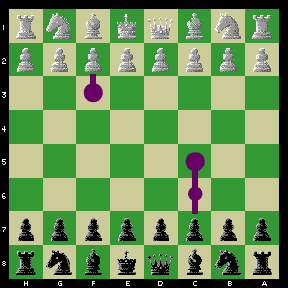 |
|
 Pawns on their starting squares may move either one or two squares straight ahead, without jumping. Pawns no longer on their starting squares may only move one square straight ahead. In the diagram, the dots show the squares to which the pawns can move. Pawns on their starting squares may move either one or two squares straight ahead, without jumping. Pawns no longer on their starting squares may only move one square straight ahead. In the diagram, the dots show the squares to which the pawns can move. |
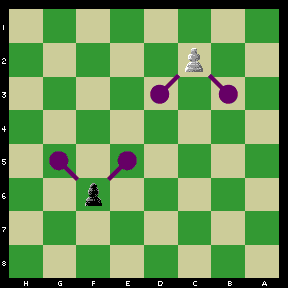 |
|
Pawns, however, do not capture as they move; instead, they capture by moving one square diagonally forward.
In the diagram, the pawns may capture opposing pieces on any of the squares marked with purple dots. |
Special Moves
Capturing En Passant: En passant, or taking in passing, allows a Pawn five rows up from its own side to capture an enemy Pawn that has taken a two-space move to land right beside it. The attacking Pawn moves diagonally into the space the other Pawn just moved over, and it captures the Pawn. It's important to remember that you must capture a given Pawn en passant immediately after its two-space move, or lose the opportunity.
|
|
|
|
A pawn may also capture an enemy pawn "in passing," or "en passant" (the French term is commonly used). This is only possible under the following conditions:
1. The enemy pawn has just made a two-square advance from its starting square. (If it happened on a previous move, it's too late to make an en passant capture).
2. A pawn could have captured the enemy pawn if it had only advanced one square instead of two.
When these conditions are met, the pawn may capture as if the enemy pawn had only advanced one square, as shown in the following diagrams. This is the only situation in chess in which moving onto an empty square results in a capture.
| Promotion |
| When a pawn advances to the last "rank," or horizontal row of squares, it is promoted into its owner's choice of a knight, bishop, rook, or queen (it may not become a king). The usual choice is a queen, the most powerful piece, and it is perfectly legal for a player to promote to a queen even though he or she already has one elsewhere on the board. Occasionally, it is better to promote to a knight (to fork two pieces or avoid stalemate) or a bishop or rook (to avoid stalemate). |
|
Castling: The Rook can also be used in Castling, a special move that can be played only once. All of the following conditions must apply before you can Castle: Neither the King nor the Rook you wish to Castle with (either the King's or Queen's Rook) has moved yet; there are no pieces between the King and that Rook; and the King is neither in check, Castling through check, nor Castling into check. To Castle, the King moves two squares toward the Rook and then the Rook jumps over it to the adjacent empty square. The King must move first; otherwise, it's just a Rook move. This is the only play where the King can move more than one space and where the Rook can jump over a chess piece.
| Castling |
Scenario A



Scenario B


 |
|
Once in the game, each player may make a special move called "Castling," in which both the king and one rook are moved. To castle, a player moves the king two squares toward either rook, then jumps that same rook over the king and stops on the square adjacent to the king.
For castling to be legal, the squares between the king and rook must all be empty, neither the king nor rook may have moved previously, the king may not be in check (under attack), and after the move neither the king nor the rook may be on a square that is under attack by an opposing piece.
|
2 The relative Values of the pieces:
Pawn values:
Pawn= 1
Knight= 3
Bishop= 3+ a tiny more
Rook= 5
Queen= 9
Next: Tactics The Essence of Chess





























